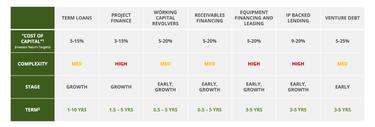
Financing Pathways for Climate Tech: Looking Beyond Corporate Equity

This is the first article in a two-part series exploring non-dilutive financing options and the opportunities for alternative financing pathways in climate tech. See the second article here.
When most founders think of raising capital, equity usually comes to mind. Many companies raise equity across seed, Series A‑C, and growth rounds to access the capital needed to grow. Companies may gain ample value from partnering with equity investors, which can often be the only option available. However, equity rounds may also result in ownership dilution at the cost of the management team and early investors. Our view is that equity can also be “expensive” for early and growth-stage companies, with investors typically targeting internal rates of return of 25%+ or 3x their capital investment. Ownership dilution and a high cost of capital may impact the long-term financial gain of management and early investors, influencing the proceeds they receive in future liquidity events such as M&A transactions or an IPO.
As an alternative to equity financing, “non-dilutive” capital provides financing without reducing equity ownership. We believe this type of capital may complement equity rounds and typically has a lower cost of capital. We also see non-dilutive funding having other potential benefits, such as extending runways and helping bridge companies to favorable financing arrangements as they achieve profitability.
Founders may consider a spectrum of non-dilutive financing options to support their growth. These range from flexible tenor debt for project development and asset equity, customized equipment leases or hardware loans, and IP-backed lending for businesses in life sciences or energy. The key categories are defined below. Note that these are not mutually exclusive nor exhaustive but provide a framework for consideration of potential financing options.
Non-dilutive financing options:
- Term Loans are flexible tenor debt arrangements for day-to-day business operations or project development. These loans provide borrowers with a lump sum of cash upfront to be repaid over a specific schedule or via a single bullet payment at the end of the loan term.
- Project Finance is the funding of ring-fenced long-term assets that will be paid back from the project’s cash flow. Project finance has historically been used throughout the renewable energy industry, but has applicability to climate tech asset deployment more broadly and can include both debt and equity structures.
- Working Capital Revolvers are lines of credit used to fund expenses for day-to-day operations. The borrower can maintain an open credit line up to a specified limit and make minimum monthly payments. Funds can be borrowed, repaid, and then reborrowed repeatedly.
- Receivables Financing is financing tied to accounts receivable that frees up working capital as a company scales.
- Equipment Financing and Leasing provides customized, non-dilutive funding for valuable equipment. This can help companies finance the purchase of expensive equipment to spread the cost over the life of an asset or enable companies to free up capital to invest in other areas of the business.
- Intellectual Property (“IP”) Backed Lending provides debt for businesses lacking traditional credit options but can offer patents, trademarks, or other IP agreements to lenders as collateral.
- Venture Debt is designed for early-stage, high-growth companies with VC backing. It is a loan taken by a company to be repaid with interest during the loan tenure.
These non-dilutive financing options may differ not only across structure, but also across term, complexity, prevalence at different stages in a company’s life cycle, and cost. The table below summarizes key characteristics.

We believe alternative financing pathways are particularly critical to scaling climate assets and solutions. In our next article, we will look at the role non-dilutive financing can play in climate tech and when companies may want to look into alternative financing options.
Title image source: Adobe Stock


